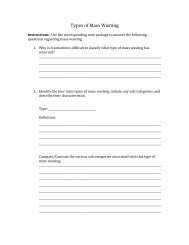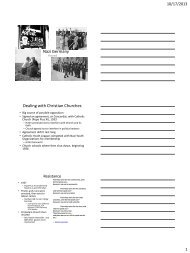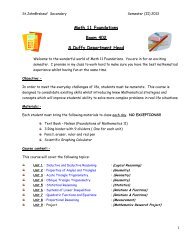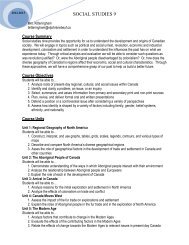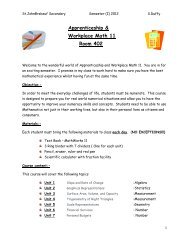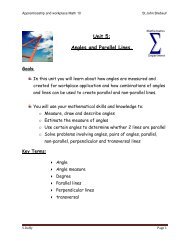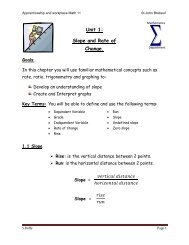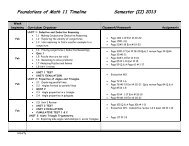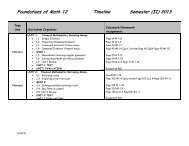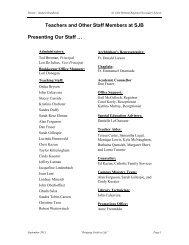Unit 4 notes - St John Brebeuf
Unit 4 notes - St John Brebeuf
Unit 4 notes - St John Brebeuf
Create successful ePaper yourself
Turn your PDF publications into a flip-book with our unique Google optimized e-Paper software.
Apprenticeship and workplace Math 11<br />
<strong>St</strong>.<strong>John</strong> <strong>Brebeuf</strong><br />
Goals:<br />
<strong>Unit</strong> 4:<br />
Trigonometry of Right<br />
Triangles<br />
Mathematics<br />
Department<br />
In this chapter you will<br />
Use Trigonometry to calculate distances and angles.<br />
Solve complex problems by breaking them down into 2 or 3 right<br />
triangles.<br />
Use right triangles to solve problems in 3-D<br />
Key Terms: You will be able to define and use the following terms:<br />
2 angled problem<br />
3 angled problem<br />
4.1 Solving for Angles, Lengths and Distances:<br />
‣ Transit: a surveying instrument used to measure horizontal and<br />
vertical angles.<br />
Opposite<br />
Hypotenuse<br />
<br />
Adjacent<br />
S.Duffy Page 1
Apprenticeship and workplace Math 11<br />
<strong>St</strong>.<strong>John</strong> <strong>Brebeuf</strong><br />
Sin = Cos = Tan =<br />
Example 1:<br />
Ethan buys a used portable conveyor for stockpiling landscaping<br />
materials such as gravel in his maintenance yard. The conveyor has a<br />
length along the belt of 12m, and makes a maximum angle of 15 with<br />
the ground.<br />
a) Sketch the conveyor. Label your diagram with your information.<br />
b) What is the maximum height of gravel stockpile this conveyor can<br />
make<br />
c) The gravel stockpile is in the shape of a cone and makes an angle of<br />
37 with the ground. What volume of material can Ethan store in the<br />
stockpile<br />
S.Duffy Page 2
Apprenticeship and workplace Math 11<br />
<strong>St</strong>.<strong>John</strong> <strong>Brebeuf</strong><br />
Solution:<br />
a) 15<br />
12m<br />
h<br />
15<br />
b) SOH-CAH-TOA<br />
c)<br />
3.106m<br />
37<br />
r<br />
S.Duffy Page 3
Apprenticeship and workplace Math 11<br />
<strong>St</strong>.<strong>John</strong> <strong>Brebeuf</strong><br />
Calculate r the radius of the cone:<br />
SOH-CAH-TOA<br />
Calculate the volume of the cone<br />
Volume cone<br />
= x area of base x height<br />
S.Duffy Page 4
Apprenticeship and workplace Math 11<br />
<strong>St</strong>.<strong>John</strong> <strong>Brebeuf</strong><br />
B<br />
O D A<br />
Chord = BC<br />
Radius =OB=OA=OC<br />
C<br />
‣ Chord: a line that links two points on the circumference of the<br />
circle.<br />
Example 2:<br />
A rancher who lives near 100 Mile House, BC, has a piece of property<br />
shown on the plan below. He is planning to build a new fence, using 3<br />
strands of barbed wire around the perimeter. How much wire will he<br />
need for the fence<br />
200m<br />
a<br />
100<br />
b<br />
500m<br />
50<br />
S.Duffy Page 5
Apprenticeship and workplace Math 11<br />
<strong>St</strong>.<strong>John</strong> <strong>Brebeuf</strong><br />
Solution:<br />
Split the property into 2 right triangles and a rectangle<br />
a<br />
200m<br />
e<br />
100 f c b<br />
d<br />
500m<br />
50<br />
Solve the right triangles to find c,d,e and f<br />
S.Duffy Page 6
Apprenticeship and workplace Math 11<br />
<strong>St</strong>.<strong>John</strong> <strong>Brebeuf</strong><br />
Find a = c – f and b = d + e<br />
Calculate the perimeter<br />
*** 3 strands of barbed wire!!!!!!<br />
Example 3:<br />
Li is making a kite for a festival, as shown in the diagram<br />
45cm<br />
e<br />
45 a 30<br />
d<br />
b<br />
g c f<br />
a) What will be the length of the<br />
2 cross pieces that will be the<br />
frame<br />
b) Calculate the length of the<br />
string that will form the outer<br />
perimeter of the kite.<br />
c) What area of fabric will be<br />
needed to cover the whole kite<br />
S.Duffy Page 7
Apprenticeship and workplace Math 11<br />
<strong>St</strong>.<strong>John</strong> <strong>Brebeuf</strong><br />
Solution:<br />
a) The length of the 2 cross pieces are a + c and b + d<br />
We need to solve each of the right triangles so number them 1-4<br />
so we can refer to each one and keep track of our calculations.<br />
1.<br />
2.<br />
S.Duffy Page 8
Apprenticeship and workplace Math 11<br />
<strong>St</strong>.<strong>John</strong> <strong>Brebeuf</strong><br />
3.<br />
4.<br />
S.Duffy Page 9
Apprenticeship and workplace Math 11<br />
<strong>St</strong>.<strong>John</strong> <strong>Brebeuf</strong><br />
b) Perimeter of the kite = 45 + e + f + g<br />
c)<br />
Area 1 = Area 2 =<br />
Area 3 = Area 4 =<br />
Complete notebook assignment page 177 # 1-10 odd<br />
S.Duffy Page 10
Apprenticeship and workplace Math 11<br />
<strong>St</strong>.<strong>John</strong> <strong>Brebeuf</strong><br />
4.2: Solving Complex Problems in the Real World:<br />
Example1:<br />
A tunnel through a hill has an angle of elevation of 3.5, and a direction<br />
of 22 north of east. The length of the tunnel along its floor is 1400m.<br />
Examine the diagram below:<br />
3.5 1400m Exit B<br />
Entrance A h Elevation C<br />
22<br />
North<br />
East<br />
a) What is the difference in elevation between the entrance and the<br />
exit of the tunnel<br />
b) How far north of the entrance is the tunnel exit<br />
c) How far east of the entrance is the tunnel exit<br />
Solution:<br />
a) To calculate the difference in elevation draw triangle ABC<br />
1400m<br />
B<br />
3.5<br />
A h C<br />
S.Duffy Page 11
Apprenticeship and workplace Math 11<br />
<strong>St</strong>.<strong>John</strong> <strong>Brebeuf</strong><br />
b) To calculate how far north and east of the tunnel you need to<br />
calculate the distance between the entrance and exit ie h in the<br />
triangle above.<br />
1400m<br />
B<br />
3.5 85m<br />
A h C<br />
You can use SOH-CAH-TOA or Pythagorean Theorem to find h<br />
S.Duffy Page 12
Apprenticeship and workplace Math 11<br />
<strong>St</strong>.<strong>John</strong> <strong>Brebeuf</strong><br />
Now find the distance north<br />
22<br />
1397<br />
east<br />
north<br />
c) Now find the distance east<br />
S.Duffy Page 13
Apprenticeship and workplace Math 11<br />
<strong>St</strong>.<strong>John</strong> <strong>Brebeuf</strong><br />
Example 2:<br />
Justin is laying out a ramp to go up a 30 slope in a park. Because the<br />
ramp may not have a slope greater than 1:20 so it can be used<br />
comfortably by wheelchairs and motorized scooters, he must angle it<br />
across the slope. The total change in elevation is 4 feet.<br />
Insert picture page 187<br />
a) What is the angle that the ramp must make with the base of the<br />
hill<br />
b) What width of hill is needed to build the ramp without using a<br />
switchback<br />
c) How can Justin used the calculated information to lay out the ramp<br />
without having to measure an angle on the slope<br />
S.Duffy Page 14
Apprenticeship and workplace Math 11<br />
<strong>St</strong>.<strong>John</strong> <strong>Brebeuf</strong><br />
Solution:<br />
a) To calculate angle A we need l and b<br />
We know that the ramp has a slope of 1:20<br />
Tan C =<br />
Find C<br />
Use C to find l<br />
4 l<br />
2.862<br />
S.Duffy Page 15
Apprenticeship and workplace Math 11<br />
<strong>St</strong>.<strong>John</strong> <strong>Brebeuf</strong><br />
Now find b<br />
4 b<br />
30<br />
Use l and b to find A<br />
b<br />
l<br />
A<br />
S.Duffy Page 16
Apprenticeship and workplace Math 11<br />
<strong>St</strong>.<strong>John</strong> <strong>Brebeuf</strong><br />
b) You can use SOH-CAH-TOA or Pythagorean Theorem to find w<br />
l<br />
b 5.731<br />
w<br />
c)<br />
_____________________________________________________<br />
_____________________________________________________<br />
_____________________________________________________<br />
_____________________________________________________<br />
‣ Angle of Elevation: The angle formed between the horizontal<br />
and the line of sight when looking upwards. Sometimes it is<br />
referred to as the angle of inclination<br />
Line of sight<br />
Angle of elevation<br />
Horizontal<br />
S.Duffy Page 17
Apprenticeship and workplace Math 11<br />
<strong>St</strong>.<strong>John</strong> <strong>Brebeuf</strong><br />
‣ Angle of Depression: The angle formed between the horizontal<br />
and the line of sight when looking downwards.<br />
Horizontal<br />
Angle of depression<br />
Line of sight<br />
‣ Clinometer: An instrument for measuring angles of elevation and<br />
depression<br />
Example 3:<br />
Ellie is standing on the edge of a building. She can see that the angle<br />
of elevation to the top of the next building is 46 and the angle of<br />
depression to the bottom of the building is 62. If the building is 30m<br />
away, how tall is the building<br />
y<br />
x<br />
46<br />
622 62<br />
30m<br />
S.Duffy Page 18
Apprenticeship and workplace Math 11<br />
<strong>St</strong>.<strong>John</strong> <strong>Brebeuf</strong><br />
Solution:<br />
To find the solution we need to calculate x + y<br />
First we need to find x and y<br />
30<br />
62<br />
Y<br />
x<br />
46<br />
30<br />
S.Duffy Page 19
Apprenticeship and workplace Math 11<br />
<strong>St</strong>.<strong>John</strong> <strong>Brebeuf</strong><br />
Example 4:<br />
Captain Ji sights an island in the distance. He uses a clinometer to<br />
measure the angle of elevation to the top of the Island as 32. He<br />
sails 400m closer to the island and takes another sighting. The angle<br />
of elevation from this closer position is 58.<br />
What is the height of the island<br />
Solution:<br />
Draw a good diagram of the situation<br />
A<br />
y<br />
B 58 D 32 C<br />
X<br />
400m<br />
S.Duffy Page 20
Apprenticeship and workplace Math 11<br />
<strong>St</strong>.<strong>John</strong> <strong>Brebeuf</strong><br />
1 st use the tan ratio for triangle ABD<br />
A<br />
y<br />
B 58 D<br />
X<br />
2 nd use the tangent ratio for triangle ABC<br />
A<br />
y<br />
B 32 C<br />
x + 400<br />
S.Duffy Page 21
Apprenticeship and workplace Math 11<br />
<strong>St</strong>.<strong>John</strong> <strong>Brebeuf</strong><br />
3 rd solve the pair of equations<br />
Complete notebook assignment page 195 # 1-7<br />
Complete <strong>Unit</strong> Review page 202 # 1-12 even<br />
S.Duffy Page 22
Apprenticeship and workplace Math 11<br />
<strong>St</strong>.<strong>John</strong> <strong>Brebeuf</strong><br />
Reflect on your learning<br />
Now check the box that applies to you :<br />
RED<br />
AMBER GREEN<br />
I understand all the key terms.<br />
I can solve problems with more<br />
than one right triangle, using<br />
SOH-CAH-TOA and<br />
Pythagorean Theorem.<br />
I can solve problems involving<br />
right triangles in 2 -D.<br />
I can solve problems involving<br />
right triangles in 3 -D.<br />
S.Duffy Page 23
Apprenticeship and workplace Math 11<br />
<strong>St</strong>.<strong>John</strong> <strong>Brebeuf</strong><br />
I can solve problems involving<br />
Angles of elevation and angle of<br />
depression.<br />
I have completed all<br />
homework assignments.<br />
I have attended tutorials<br />
for extra help.<br />
I am ready to sit my<br />
unit 4 test.<br />
Target:<br />
In my <strong>Unit</strong> Test I hope to achieve<br />
%<br />
<strong>St</strong>udent’s Signature ____________________<br />
Date__________<br />
S.Duffy Page 24



